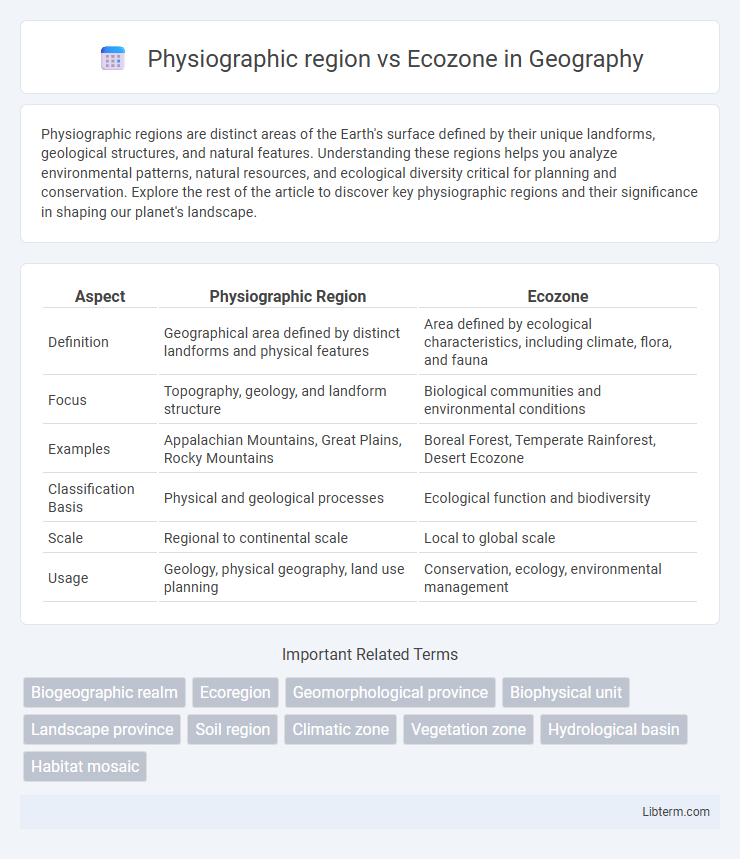Physiographic regions are distinct areas of the Earth's surface defined by their unique landforms, geological structures, and natural features. Understanding these regions helps you analyze environmental patterns, natural resources, and ecological diversity critical for planning and conservation. Explore the rest of the article to discover key physiographic regions and their significance in shaping our planet's landscape.
Table of Comparison
| Aspect | Physiographic Region | Ecozone |
|---|---|---|
| Definition | Geographical area defined by distinct landforms and physical features | Area defined by ecological characteristics, including climate, flora, and fauna |
| Focus | Topography, geology, and landform structure | Biological communities and environmental conditions |
| Examples | Appalachian Mountains, Great Plains, Rocky Mountains | Boreal Forest, Temperate Rainforest, Desert Ecozone |
| Classification Basis | Physical and geological processes | Ecological function and biodiversity |
| Scale | Regional to continental scale | Local to global scale |
| Usage | Geology, physical geography, land use planning | Conservation, ecology, environmental management |
Introduction to Physiographic Regions and Ecozones
Physiographic regions are distinct areas defined by physical landscape features such as landforms, geology, and topography, which influence soil formation and hydrology. Ecozones represent broader ecological units characterized by consistent climate patterns, vegetation types, and biodiversity, integrating both biotic and abiotic factors. Understanding the interaction between physiographic regions and ecozones is essential for effective environmental management and conservation planning.
Defining Physiographic Regions
Physiographic regions are defined by their distinct landforms, geological structures, and physical geography, emphasizing features such as mountain ranges, plateaus, and valleys. These regions are characterized by their geomorphology and topographic relief rather than biological factors. Unlike ecozones, which focus on ecosystems and biodiversity patterns, physiographic regions provide a framework for understanding Earth's surface processes and terrain variations.
Understanding Ecozones
Ecozones represent large ecological areas defined by distinct combinations of climate, landforms, vegetation, soil, and wildlife, emphasizing biogeographic patterns rather than just physical geography. Unlike physiographic regions that focus primarily on geological and topographic features, ecozones integrate biological and ecological attributes to highlight biodiversity and ecosystem function. Understanding ecozones facilitates targeted conservation efforts and sustainable land management by acknowledging species distribution and ecological processes across broad landscapes.
Key Differences Between Physiographic Regions and Ecozones
Physiographic regions are defined by distinct landforms, geological structures, and physical landscapes, reflecting the Earth's surface features shaped by tectonic and erosional processes. Ecozones, in contrast, represent large ecological areas characterized by unique climate, vegetation, and biodiversity patterns, emphasizing biological and environmental interactions. The key difference lies in physiographic regions focusing on abiotic physical geography, while ecozones center on biotic ecosystems and ecological relationships.
Criteria for Delineating Physiographic Regions
Physiographic regions are delineated based on criteria such as landform characteristics, geological history, rock type, and structural features, emphasizing physical terrain and topography. In contrast, ecozones focus on biological factors including climate, vegetation, and ecosystem processes. The delineation of physiographic regions involves analyzing geomorphology and lithology to categorize distinct physical landscapes.
Factors Influencing Ecozone Classification
Ecozone classification primarily depends on climatic factors, vegetation types, and soil characteristics, reflecting the interaction of biotic and abiotic elements within a landscape. In contrast, physiographic regions are defined mainly by geological formations, landforms, and topography influencing physical terrain. Temperature patterns, precipitation, and species distribution play a decisive role in ecozone delineation, distinguishing ecological boundaries beyond mere physical geography.
Examples of Physiographic Regions
Physiographic regions, such as the Rocky Mountains, Great Plains, and Appalachian Highlands, are defined by distinct landforms, geological structures, and physical characteristics. Ecozones, in contrast, categorize areas based on ecological factors including climate, vegetation, and wildlife, like the Boreal Shield or Pacific Maritime ecozones. Understanding physiographic regions provides critical insight into Earth's topography and geological history, essential for studies in geomorphology and natural resource management.
Examples of Ecozones
Ecozones represent broad ecological regions defined by distinct biotic and abiotic features, such as the Nearctic ecozone encompassing North America's temperate and boreal forests, grasslands, and arctic tundra. Examples include the Afrotropic ecozone, characterized by tropical rainforests and savannahs in sub-Saharan Africa, and the Palearctic ecozone, which spans Europe, North Asia, and parts of North Africa with diverse ecosystems ranging from deserts to boreal forests. Unlike physiographic regions that focus primarily on physical landforms, ecozones emphasize the biological and climatic factors influencing habitat and species distribution.
Importance of Distinguishing Between Both Concepts
Distinguishing between physiographic regions and ecozones is crucial for effective environmental management and conservation planning, as physiographic regions emphasize geological and landform characteristics while ecozones focus on ecological patterns and biodiversity. Accurate identification of these units helps policymakers implement region-specific strategies addressing soil conservation, habitat preservation, and sustainable land use. Integrating both concepts facilitates comprehensive understanding of landscape functionality and ecosystem services across diverse geographical scales.
Implications for Environmental Management and Conservation
Physiographic regions are defined by distinct landforms and geological structures, influencing soil types, hydrology, and vegetation patterns crucial for environmental management. Ecozones, characterized by ecological features such as climate, flora, and fauna, guide biodiversity conservation and habitat protection strategies. Integrating physiographic and ecozone data enhances the effectiveness of conservation planning by addressing both abiotic and biotic components of ecosystems.
Physiographic region Infographic

 libterm.com
libterm.com